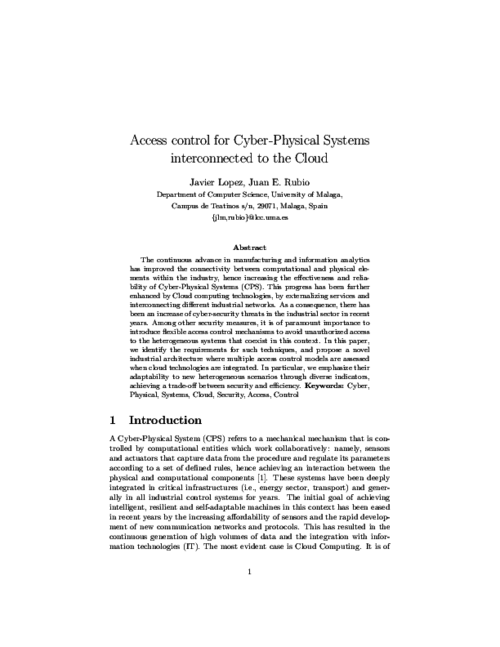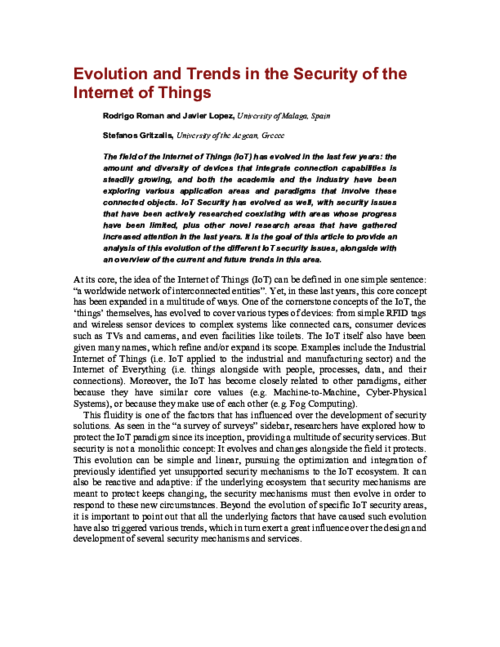Computer Science Review, vol. 49, no. 100567, Elsevier, 05/2023. DOI
Abstract
Secure Multi-party Computation (SMPC) is a family of protocols which allow some parties to compute a function on their private inputs, obtaining the output at the end and nothing more. In this work, we focus on a particular SMPC problem named Private Set Intersection (PSI). The challenge in PSI is how two or more parties can compute the intersection of their private input sets, while the elements that are not in the intersection remain private. This problem has attracted the attention of many researchers because of its wide variety of applications, contributing to the proliferation of many different approaches. Despite that, current PSI protocols still require heavy cryptographic assumptions that may be unrealistic in some scenarios. In this paper, we perform a Systematic Literature Review of PSI solutions, with the objective of analyzing the main scenarios where PSI has been studied and giving the reader a general taxonomy of the problem together with a general understanding of the most common tools used to solve it. We also analyze the performance using different metrics, trying to determine if PSI is mature enough to be used in realistic scenarios, identifying the pros and cons of each protocol and the remaining open problems.
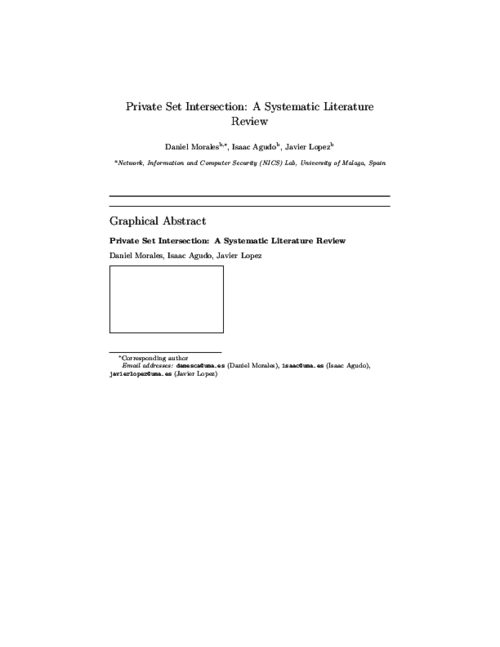
International Journal of Information Security, Springer, 2020. DOI
Abstract
Nowadays, smart home devices like Amazon Echo and Google Home have reached mainstream popularity.
Being in the homes of users, these devices are intrinsically intrusive, being able to access details such as users' name, gender, home address, calendar appointments and others.
There are growing concerns about indiscriminate data collection and invasion of user privacy in smart home devices, but studies show that perceived benefits are exceeding perceived risks when it comes to consumers.
As a result, consumers are placing a lot of trust in these devices, sometimes without realizing it.
Improper trust assumptions and security controls can lead to unauthorized access and control of the devices, which can result in serious consequences.
In this paper, we explore the behaviour of devices such as Amazon Echo and Google Home in a smart home setting with respect to trust relationships and propose a trust model to improve these relationships among all the involved actors.
We have evaluated how trust was built and managed from the initial set up phase to the normal operation phase, during which we performed a number of interaction tests with different types of users (i.e. owner, guests).
As a result, we were able to assess the effectiveness of the provided security controls and identify potential relevant security issues. In order to address the identified issues, we defined a trust model and propose a solution based on it for further securing smart home systems.
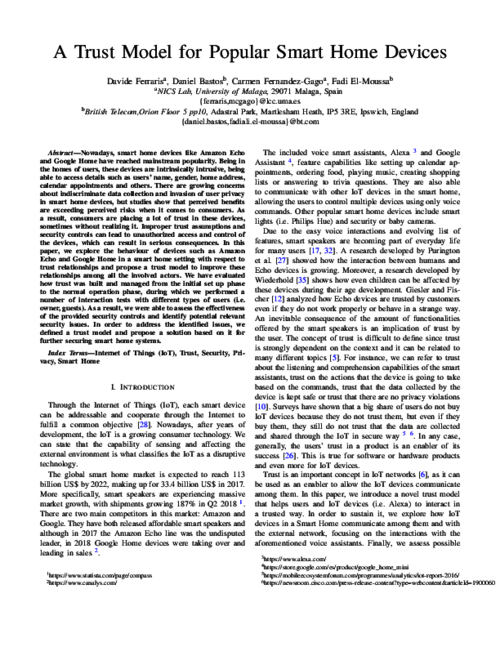
The 20th World Conference on Information Security Applications: WISA-Workshop 2019, Springer, 2019.
Abstract
In recent times, smart home devices like Amazon Echo and Google Home have reached mainstream popularity. These devices are intrinsically intrusive, being able to access user’s personal information. There are growing concerns about indiscriminate data collection and invasion of user privacy in smart home devices. Improper trust assumptions and security controls can lead to unauthorized access of the devices, which can have severe consequences (i.e. safety risks). In this paper, we analysed the behaviour of smart home devices with respect to trust relationships. We set up a smart home environment to evaluate how trust is built and managed. Then, we performed a number of interaction tests with different types of users (i.e. owner, guests). As a result, we were able to assess the effectiveness of the provided security controls and identify some relevant security issues. To address them, we defined a trust model and proposed a solution based on it for securing smart home devices.
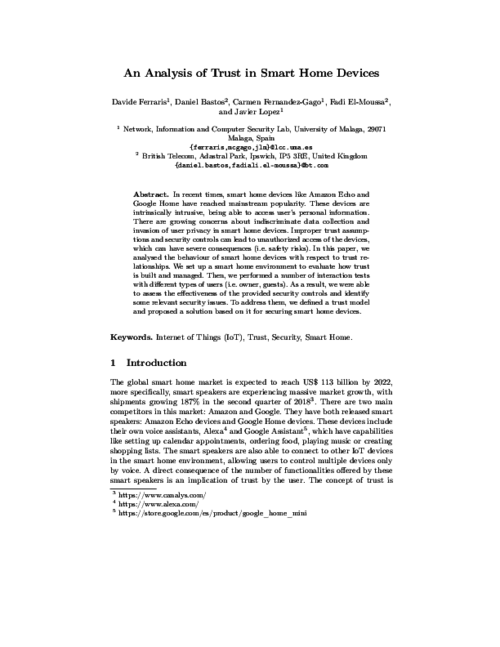
IEEE Internet of Things Journal, vol. 6, issue 5, IEEE Computer Society, pp. 8038-8045, 10/2019. DOI
Abstract
Edge Computing paradigms are expected to solve some major problems affecting current application scenarios that rely on Cloud computing resources to operate. These novel paradigms will bring computational resources closer to the users and by doing so they will not only reduce network latency and bandwidth utilization but will also introduce some attractive context-awareness features to these systems. In this paper we show how the enticing features introduced by Edge Computing paradigms can be exploited to improve security and privacy in the critical scenario of vehicular networks (VN), especially existing authentication and revocation issues. In particular, we analyze the security challenges in VN and describe three deployment models for vehicular edge computing, which refrain from using vehicular- to-vehicular communications. The result is that the burden imposed to vehicles is considerably reduced without sacrificing the security or functional features expected in vehicular scenarios.
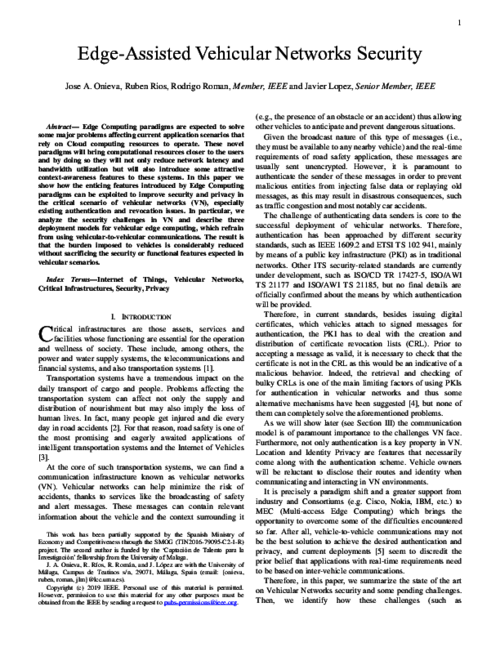
IEEE Internet of Things Journal, vol. 6, issue 3, IEEE Computer Society, pp. 4774-4781, 06/2019. DOI
Abstract
The Internet of Things (IoT) and Edge Computing are starting to go hand in hand. By providing cloud services close to end-users, edge paradigms enhance the functionality of IoT deployments, and facilitate the creation of novel services such as augmented systems. Furthermore, the very nature of these paradigms also enables the creation of a proactive defense architecture, an immune system, which allows authorized immune cells (e.g., virtual machines) to traverse edge nodes and analyze the security and consistency of the underlying IoT infrastructure. In this article, we analyze the requirements for the development of an immune system for the IoT, and propose a security architecture that satisfies these requirements. We also describe how such a system can be instantiated in Edge Computing infrastructures using existing technologies. Finally, we explore the potential application of immune systems to other scenarios and purposes.
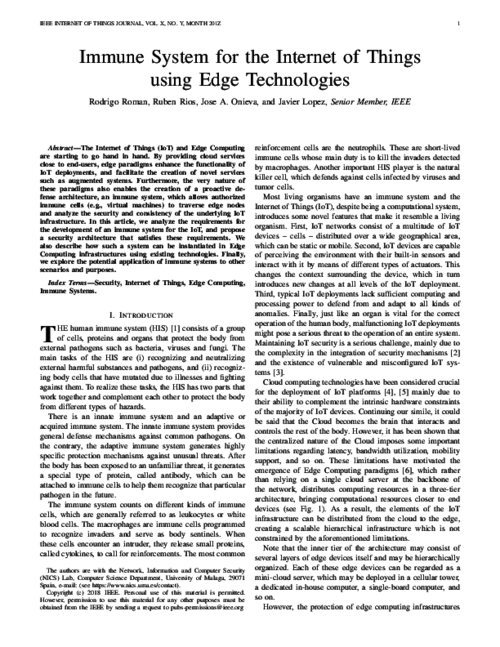
Computer Networks, vol. 134, Elsevier, pp. 46 - 54, 2018. DOI
15th International Conference on Trust, Privacy and Security in Digital Business (TrustBus 2018), vol. LNCS 11033, Springer Nature Switzerland AG, pp. 229–243, 09/2018. DOI
Abstract
Recent news have raised concern regarding the security on the IoT field. Vulnerabilities in devices are arising and honeypots are an excellent way to cope with this problem. In this work, current solutions for honeypots in the IoT context, and other solutions adaptable to it are analyzed in order to set the basis for a methodology that allows deployment of IoT honeypot.
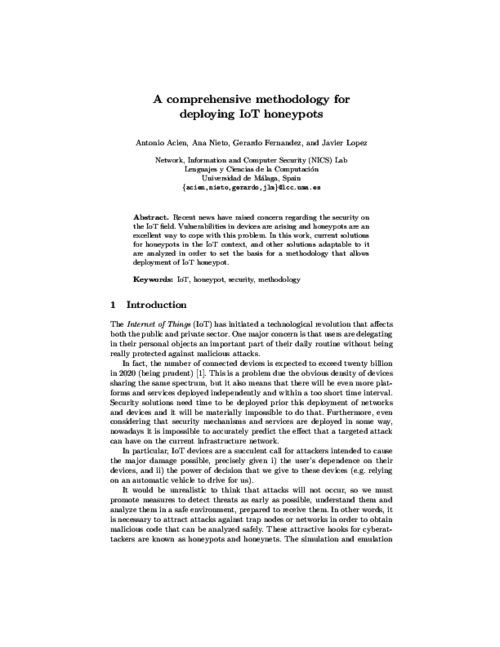
IEEE Computer, vol. 51, issue 7, IEEE Computer Society, pp. 16-25, 07/2018. DOI
KSII Transactions on Internet and Information Systems, vol. 12, no. 8, KSII, pp. 3567-3588, 08/2018. DOI
Abstract
In the Internet of Things (IoT) concept, devices communicate autonomously with applications in the Internet. A significant aspect of IoT that makes it stand apart from present-day networked devices and applications is a) the very large number of devices, produced by diverse makers and used by an even more diverse group of users; b) the applications residing and functioning in what were very private sanctums of life e.g. the car, home, and the people themselves. Since these diverse devices require high-level security, an operational model for an IoT system is required, which has built-in security. We have proposed the societal model as a simple operational model. The basic concept of the model is borrowed from human society – there will be infants, the weak and the handicapped who need to be protected by guardians. This natural security mechanism works very well for IoT networks which seem to have inherently weak security mechanisms. In this paper, we discuss the requirements of the societal model and examine its feasibility by doing a proof-of-concept implementation.
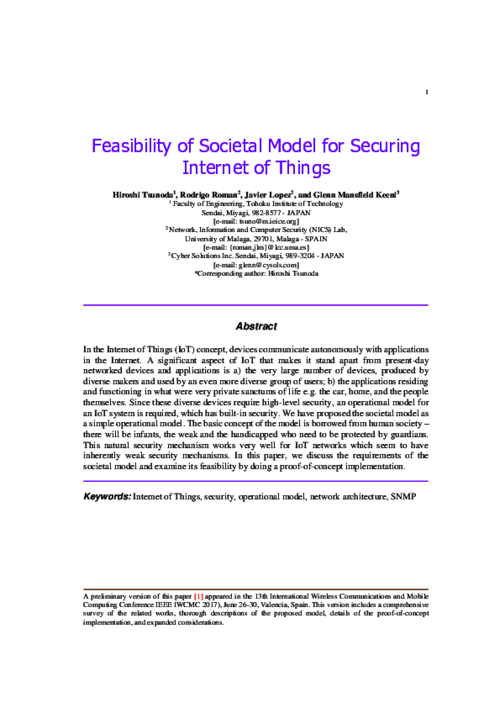
Future Generation Computer Systems, vol. 78, issue 1, Elsevier, pp. 680-698, 01/2018. DOI
Abstract
For various reasons, the cloud computing paradigm is unable to meet certain requirements (e.g. low latency and jitter, context awareness, mobility support) that are crucial for several applications (e.g. vehicular networks, augmented reality). To fulfil these requirements, various paradigms, such as fog computing, mobile edge computing, and mobile cloud computing, have emerged in recent years. While these edge paradigms share several features, most of the existing research is compartmentalised; no synergies have been explored. This is especially true in the field of security, where most analyses focus only on one edge paradigm, while ignoring the others. The main goal of this study is to holistically analyse the security threats, challenges, and mechanisms inherent in all edge paradigms, while highlighting potential synergies and venues of collaboration. In our results, we will show that all edge paradigms should consider the advances in other paradigms.
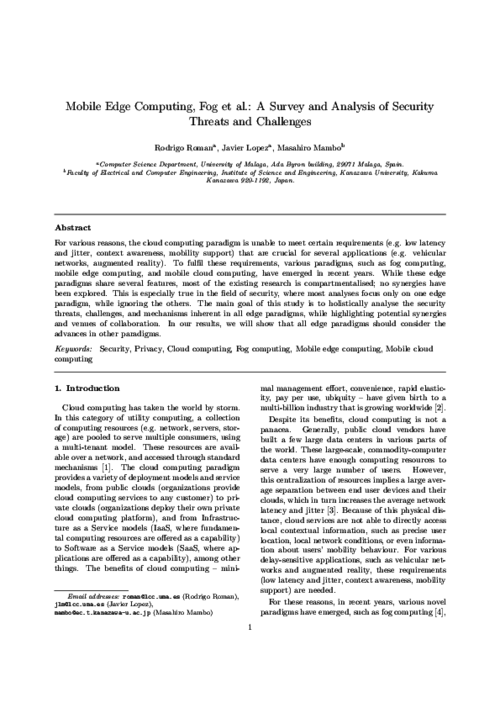
IV Jornadas Nacionales de Investigación en Ciberseguridad (JNIC 2018), Servicio Editorial de Mondragon Unibertsitatea, 06/2018.
Abstract
Los ataques cross-platform suponen un serio desafío para los mecanismos de seguridad cuando los portadores de un ataque dirigido no son conscientes de su participacion en el mismo. Es por ello que, con dispositivos y tecnologías cada vez mas entrelazadas, en constante comunicación, numerosos ataques pasan desapercibidos hasta que alcanzan su objetivo final. Estos nuevos escenarios hacen posible una vía de transmision a tener en cuenta, y que se debe abordar cuanto antes, ya que sus consecuencias, especialmente en el panorama de telecomunicaciones actual, podrían ser desoladoras. La rapida transmisión de estos ataques, y la dificultad que supone su prevencion, detección y mitigación antes de que se hagan efectivos, hacen que el problema sea particularmente preocupante. En este artículo se presentará una arquitectura para el analisis de los ataques cross-platform silenciosos, cuyo objetivo es ayudar a comprender mejor este tipo de amenazas y ofrecer soluciones que permitan mitigarlas y rastrearlas.
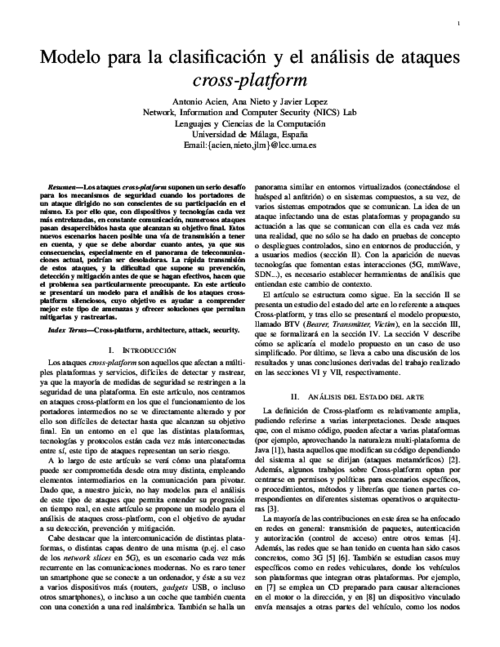
Computer Communications, vol. 68, Elsevier, pp. 33-46, 09/2015. DOI
Abstract
The lack of abstraction in a growing semantic, virtual and abstract world poses new challenges for assessing security and QoS tradeoffs. For example, in Future Internet scenarios, where Unified Communications (UC) will take place, being able to predict the final devices that will form the network is not always possible. Without this information the analysis of the security and QoS tradeoff can only be based on partial information to be completed when more information about the environment is available. In this paper, we extend the description of context-based parametric relationship model, providing a tool for assessing the security and QoS tradeoff (SQT) based on interchangeable contexts. Our approach is able to use the heterogeneous information produced by scenarios where UC is present.
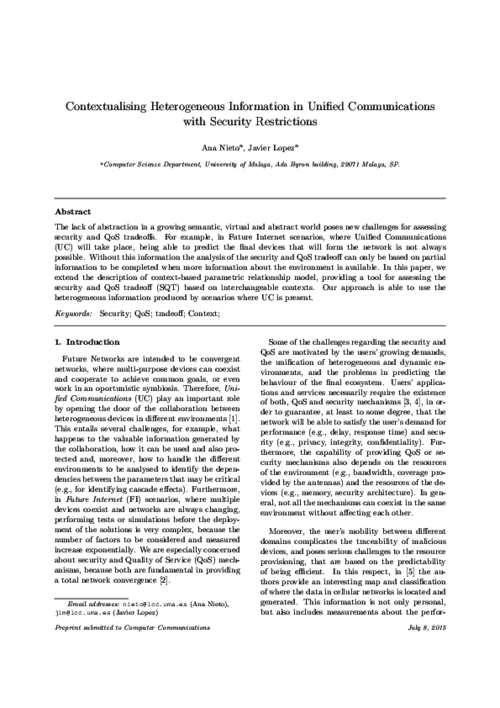
International Journal of Critical Infrastructure Protection (IJCIP), vol. 8, Elsevier Science, pp. 53–66, 01/2015. DOI
Abstract
Critical infrastructures play a vital role in supporting modern society. The reliability, performance, continuous operation, safety, maintenance and protection of critical infrastructures are national priorities for countries around the world. This paper explores the vulnerabilities and threats facing modern critical infrastructures with special emphasis on industrial control systems, and describes a number of protection measures. The paper also discusses some of the challenging areas related to critical infrastructure protection such as governance and security management, secure network architectures, self-healing, modeling and simulation, wide-area situational awareness, forensics and learning, and trust management and privacy.
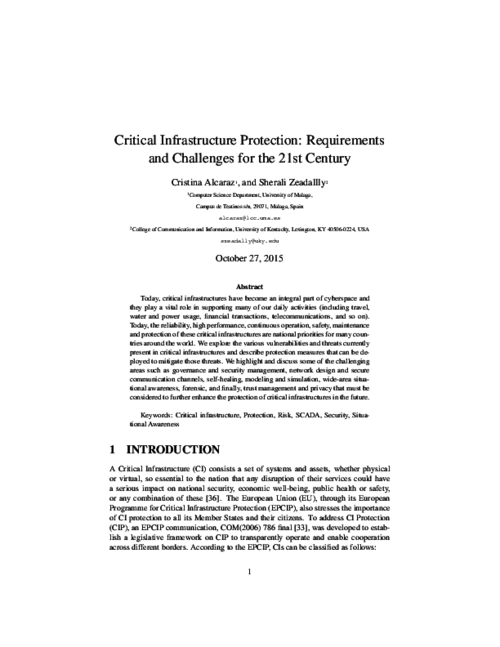
Information Sciences, vol. 321, Elsevier, pp. 205 - 223, 07/2015. DOI
Abstract
Wireless sensor networks (WSNs) are continually exposed to many types of attacks. Among these, the attacks targeted at the base station are the most devastating ones since this essential device processes and analyses all traffic generated in the network. Moreover, this feature can be exploited by a passive adversary to determine its location based on traffic analysis. This receiver-location privacy problem can be reduced by altering the traffic pattern of the network but the adversary may still be able to reach the base station if he gains access to the routing tables of a number of sensor nodes. In this paper we present HISP-NC (Homogenous Injection for Sink Privacy with Node Compromise protection), a receiver-location privacy solution that consists of two complementary schemes which protect the location of the base station in the presence of traffic analysis and node compromise attacks. The HISP-NC data transmission protocol prevents traffic analysis by probabilistically hiding the flow of real traffic with moderate amounts of fake traffic. Moreover, HISP-NC includes a perturbation mechanism that modifies the routing tables of the nodes to introduce some level of uncertainty in attackers capable of retrieving the routing information from the nodes. Our scheme is validated both analytically and experimentally through extensive simulations.
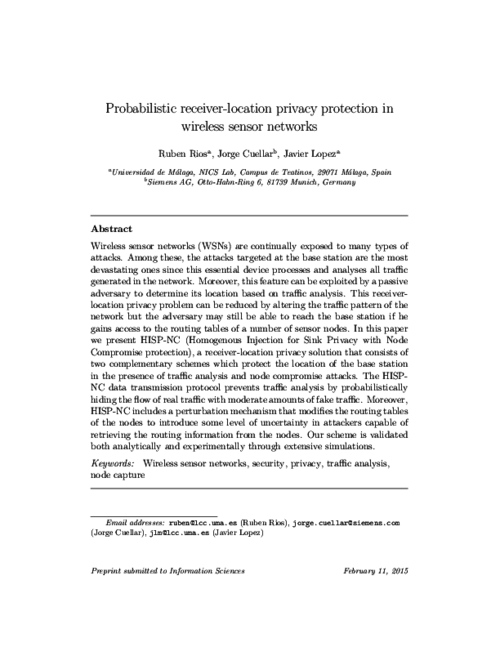
Telecommunication Systems , vol. 59, issue 1, Springer US, pp. 169-187, 05/2015. DOI
Abstract
In this article, we present relay selection policies in applications with secrecy requirements which are of interest in the fifth generation (5G) of wireless networks. More specifically, we provide a classification of relays based on their distinct communication attributes, such as processing, multiple antennas, storage, channel estimation, density and security level. In addition, we discuss the level of efficiency exhibited by each relay class, regarding their impact in delay-critical applications and green communications applications, while aiming at a specific security level at the physical layer. Then, relay selection policies are proposed taking into consideration the goals set by each application. Numerical evaluation of the proposed policies in terms of the average secrecy rate, average delay and power reduction show improved performance compared to other state-of-the-art solutions.
Mobile Networks and Applications (MONET) Journal, vol. 19, issue 1, Springer US, pp. 64-78, 02/2014. DOI
Abstract
Today, mobile platforms are multimedia devices that provide different types of traffic with the consequent particular performance demands and, besides, security concerns (e.g. privacy). However, Security and QoS requirements quite often conflict to a large degree; the mobility and heterogeneous paradigm of the Future Internet makes coexistence even more difficult, posing new challenges to overcome. Probably, one of the main challenges is to identify the specific reasons why Security and QoS mechanisms are so related to each other. In this paper, we present a Parametric Relationship Model (PRM) to identify the Security and QoS dependencies, and to elaborate on the Security and QoS tradeoff. In particular, we perform an analysis that focus on the mobile platform environment and, consequently, also considers subjective parameters such user’s experience, that is crucial for increasing the usability of new solutions in the Future Internet. The final aim of our contribution is to facilitate the development of secure and efficient services for mobile platforms.
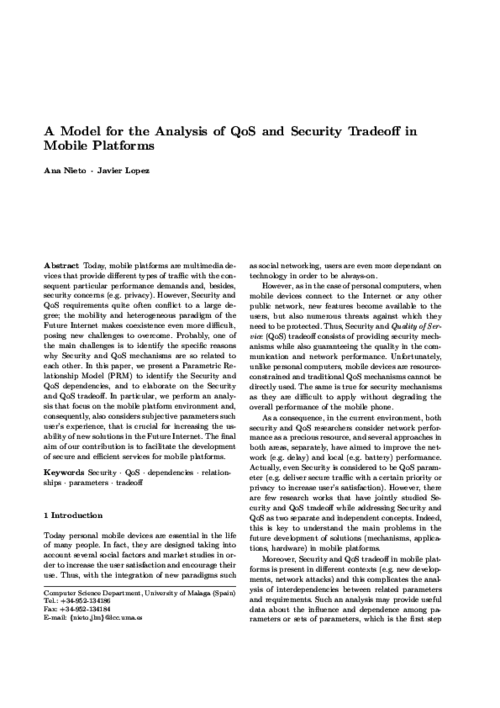
26th International Conference on Advanced Information Systems Engineering (CAiSE 2014), M. Jarke, et al. Eds., LCNS 8484, Springer, pp. 136-149, 06/2014. DOI
Abstract
Cloud sourcing consists of outsourcing data, services and infrastructure to cloud providers. Even when this outsourcing model brings advantages to cloud customers, new threats also arise as sensitive data and critical IT services are beyond customers' control. When an organization considers moving to the cloud, IT decision makers must select a cloud provider and must decide which parts of the organization will be outsourced and to which extent. This paper proposes a methodology that allows decision makers to evaluate their trust in cloud providers. The methodology provides a systematic way to elicit knowledge about cloud providers, quantify their trust factors and aggregate them into trust values that can assist the decision-making process. The trust model that we propose is based on trust intervals, which allow capturing uncertainty during the evaluation, and we define an operator for aggregating these trust intervals. The methodology is applied to an eHealth scenario.
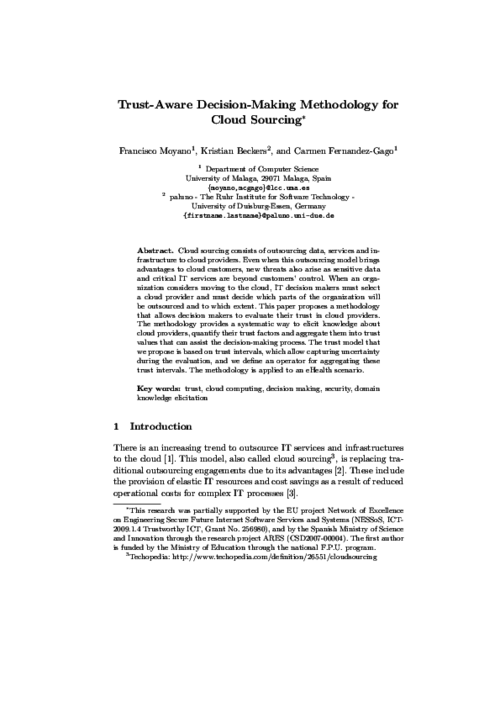
Security and Communication Networks (SCN) Journal, vol. 7, issue 12, Wiley-Blackwell, pp. 2778-2803, 2013. DOI
Abstract
Motivated by the growing convergence of diverse types of networks and the rise of concepts such as Future Internet (FI), in this paper we analyse the coexistence of security mechanisms and Quality of Service (QoS) mechanisms in resourceconstrained networks, that are relevant types of networks within the FI environment. More precisely, we analyse the current state of the research on security and QoS in the integration of Wireless Sensor Networks (WSNs), Mobile Ad-Hoc Networks (MANETs) and cellular networks. Furthermore, we propose a taxonomy to identify similarities among these technologies, as well as the requirements for network interconnection. As a result, we define a dependency-based model for the analysis of Security and QoS tradeoff, and also define a high-level integration architecture for networks in the FI setting. The final goal is to provide a critical point of view that allows to assess whether such an integration of networks can be both secure and efficient.
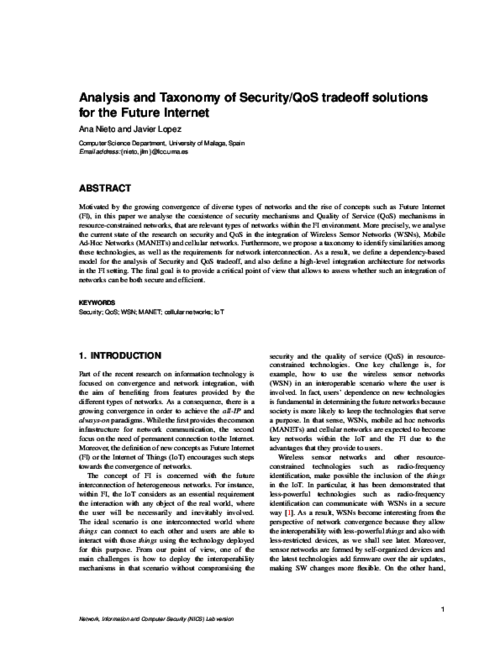
Computers & Security, vol. 38, Elsevier, pp. 14-27, OCT 2013. DOI
Abstract
Any deliberate or unsuitable operational action in control tasks of critical infrastructures, such as energy generation, transmission and distribution systems that comprise sub-domains of a Smart Grid, could have a significant impact on the digital economy: without energy, the digital economy cannot live. In addition, the vast majority of these types of critical systems are configured in isolated locations where their control depends on the ability of a few, supposedly trustworthy, human operators. However, this assumption of reliabilty is not always true. Malicious human operators (criminal insiders) might take advantage of these situations to intentionally manipulate the critical nature of the underlying infrastructure. These criminal actions could be not attending to emergency events, inadequately responding to incidents or trying to alter the normal behaviour of the system with malicious actions. For this reason, in this paper we propose a smart response mechanism that controls human operators’ operational threats at all times. Moreover, the design of this mechanism allows the system to be able to not only evaluate by itself, the situation of a particular scenario but also to take control when areas are totally unprotected and/or isolated. The response mechanism, which is based on Industrial Wireless Sensor Networks (IWSNs) for the constant monitoring of observed critical infrastructures, on reputation for controlling human operators’ actions, and on the ISA100.11a standard for alarm management, has been implemented and simulated to evaluate its feasibility for critical contexts.
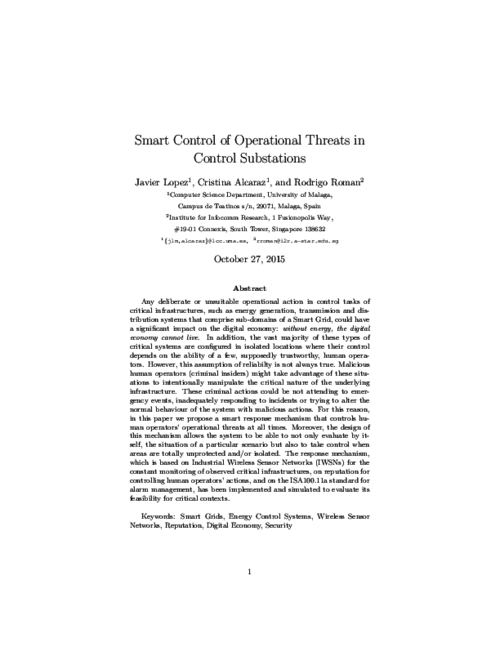
Information Systems Frontiers, vol. 14, Springer, pp. 527-540, July 2012. DOI
Abstract
Our society is becoming increasingly more IT-oriented, and the images and sounds that reflect our daily life are being stored mainly in a digital form. This digital personal life can be part of the home multimedia contents, and users demand access and possibly share these contents (such as photographs, videos, and music) in an ubiquitous way: from any location and with any device. The purpose of this article is twofold. First, we introduce the Feel@Home system, whose main objective is to enable the previously mentioned vision of an ubiquitous digital personal life. Second, we describe the security architecture of Feel@Home, analyzing the security and privacy requirements that identify which threats and vulnerabilities must be considered, and deriving the security building blocks that can be used to protect both IMS-based and VPN-based solutions.
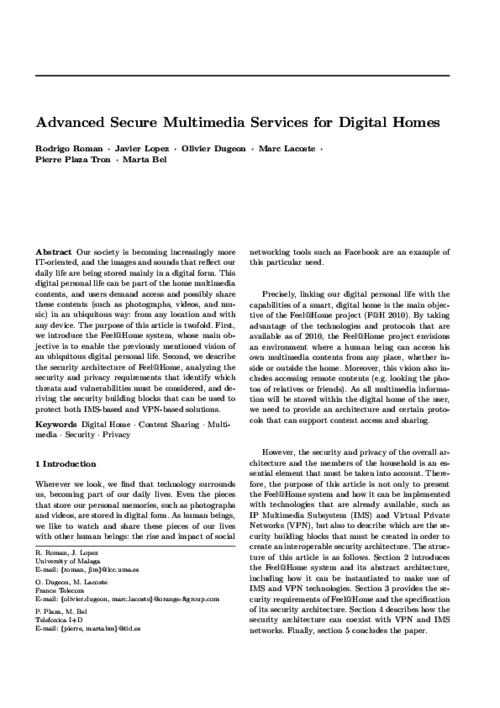
The 4th FTRA International Conference on Computer Science and its Applications (CSA 2012), Lecture Notes in Electrical Engineering 203, Springer Netherlands, pp. 13-21, 2012. DOI
Abstract
Mobile platforms are becoming a fundamental part of the user’s daily life. The human-device relationship converts the devices in a repository of personal data that may be stolen or modified by malicious users. Moreover, wireless capabilities open the door to several malicious devices, and mobility represents an added difficulty in the detection of malicious behavior and in the prevention of the same. Furthermore, smartphones are subject to quality of service (QoS) restrictions, due to the user needs for multimedia applications and, in general, the need to be always-on. However, Security and QoS requirements are largely confronted and the mobility and heterogeneous paradigm on the Future Internet makes its coexistence even more difficult, posing new challenges to overcome. We analyze the principal challenges related with Security and QoS tradeoffs in mobile platforms. As a result of our analysis we provide parametric relationships between security and QoS parameters focused on mobile platforms.
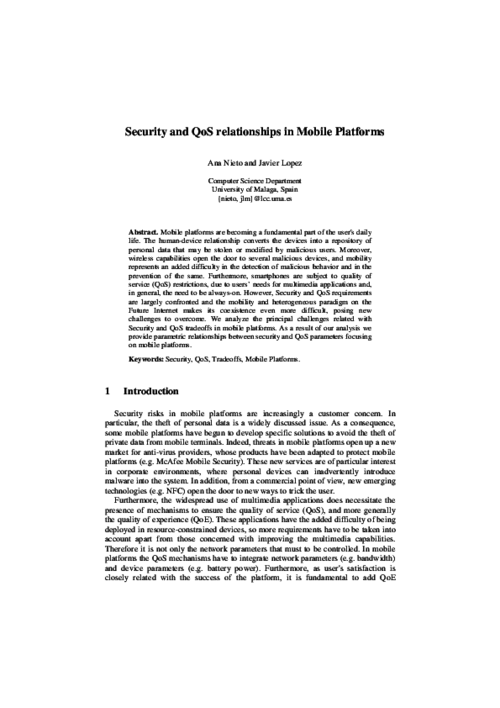
Advanced Information Networking and Applications Workshops (WAINA), 2012 26th International Conference on, IEEE, pp. 745-750, 03/2012. DOI
Abstract
Motivated by the growing convergence of diverse types of networks and the raise of new concepts such as Future Internet (FI), in this paper we present an analysis of current research on the development of security mechanisms in a tradeoff with Quality of Service (QoS) mechanisms. More precisely, we pay attention to the Security and QoS problems in resource-constrained networks that are candidates to be an important part of the FI due to their proximity to the user or because of their contribution to the information society. We analyse the current state of the research on security and QoS in the integration of sensors, MANET and cellular networks, with the aim of providing a critical point of view, allowing us to assess whether it is possible that such integration of networks is both secure and efficient.
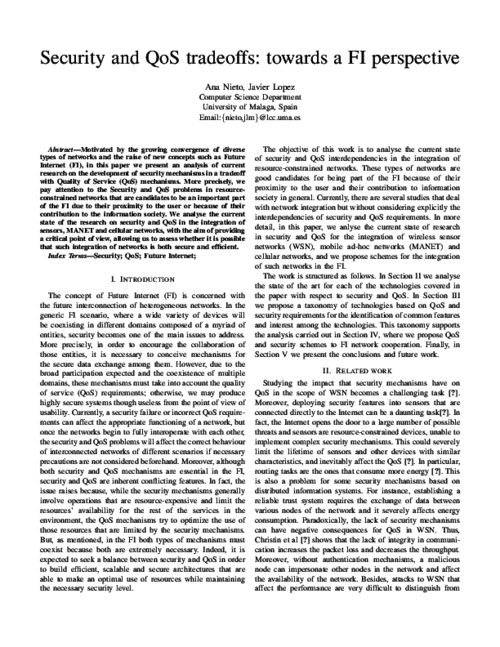
Computers & Security, vol. 31, no. 38, Elsevier, pp. 956–966, Nov 2012. DOI
Abstract
Key management in wireless sensor networks (WSN) is an active research topic. Due to the fact that a large number of key management schemes (KMS) have been proposed in the literature, it is not easy for a sensor network designer to know exactly which KMS best fits in a particular WSN application. In this article, we offer a comprehensive review on how the application requirements and the properties of various key management schemes influence each other. Based on this review, we show that the KMS plays a critical role in determining the security performance of a WSN network with given application requirements. We also develop a method that allows the network designers to select the most suitable KMS for a specific WSN network setting. In addition, the article also addresses the issues on the current state-of-the-art research on the KMS for homogeneous (i.e. non-hierarchical) networks to provide solutions for establishing link-layer keys in various WSN applications and scenarios.
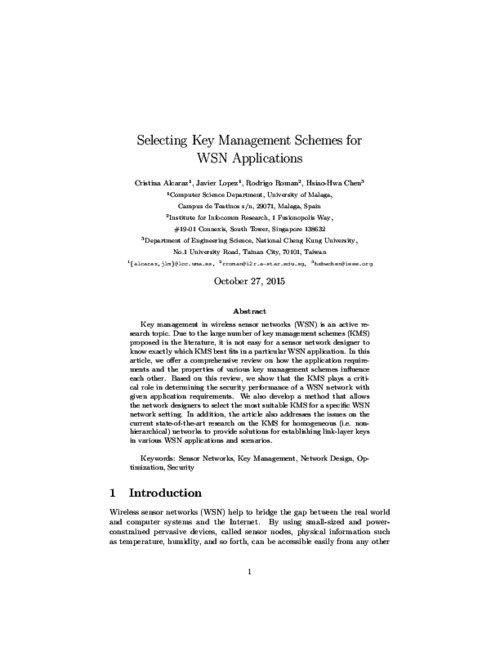
21st International Conference on Computer Communications and Networks (ICCCN), IEEE Computer Society, pp. 1-5, Jul 2012. DOI
Abstract
Migration to an electronically controlled electrical grid to transmit, distribute, and deliver power to consumers has helped enhance the reliability and efficiency of conventional electricity systems. At the same time, this digitally enabled technology called the Smart Grid has brought new challenges to businesses and consumers alike. A key component of such a grid is the smart-metering technology, which is used to collect energy consumption data from homes and transmitting it back to power distributors. A crucial concern is the privacy related to the collection and use of energy consumption data. We present an analysis of Smart Grid privacy issues and discuss recently proposed solutions that can protect the privacy of Smart Grid users.
Proceedings of the First International Conference on Security of Internet of Things, ACM, pp. 172–178, 2012. DOI
Abstract
While there has been considerable progress in the research and technological development (RTD) of the Internet of Things (IoT), there is still considerable RTD required by international communities for the trust, privacy and security research challenges arising from the constitution of the IoT architectures, infrastructures, communications, devices, objects, applications and services. In this paper, we present an thorough analysis of the ongoing and future RTD work, specifically in Europe, regarding trust, privacy and security of the Internet of Things with a view towards enabling international cooperation efforts around the globe to solve these major research challenges.
Wireless Communications and Mobile Computing, vol. 11, Wiley, pp. 267-276, 2011. DOI
Abstract
The wireless sensor networks (WSN) paradigm is especially vulnerable against external and internal attacks. Therefore, it is necessary to develop security mechanisms and protocols to protect them. These mechanisms must become an integral part of the software architecture and network stack of a sensor node. A question that remains is how to achieve this integration. In this paper we check how both academic and industrial solutions tackle this issue, and we present the concept of a transversal layer, where all the different security mechanisms could be contained. This way, all the elements of the architecture can interact with the security mechanisms, and the security mechanisms can have a holistic point of view of the whole architecture. We discuss the advantages of this approach, and also present how the transversal layer concept was applied to a real middleware architecture.
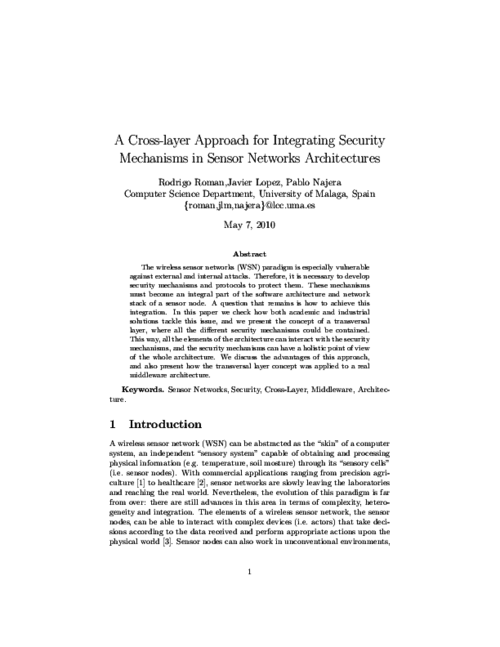
5th IEEE International Conference on Mobile Ad Hoc and Sensor Systems (MASS’08), IEEE, pp. 796-801, September, 2008. DOI
Abstract
An out-of-band (OoB) channel can be defined as an extra channel, different from the main wireless channel, that has additional security properties. They are specially suitable for protecting spontaneous interactions and exchanging sensitive data between previously unknown devices. Due to the vulnerable nature of wireless sensor networks (WSN), these kind of channels might be useful for protecting certain sensor network operations. In this paper we analyze the applicability of out-of-band channels to wireless sensor networks, and specify why an optical channel should be a good candidate for implementing an extra channel in sensor nodes. Also, we analyze how the existing security threats may affect this type of channel. Finally, the suitability and usability of optical channels for sensor networks is demonstrated by means of a prototype.
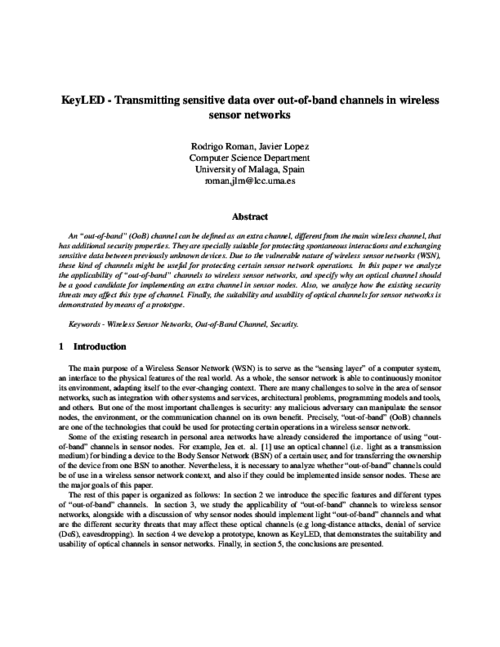
3rd Symposium of Ubiquitous Computing and Ambient Intelligence 2008, Advances in Soft Computing 51/2009, Springer, pp. 134-138, October, 2008. DOI
Abstract
Seamless human identification and authentication in the information system is a fundamental step towards the transparent interaction between the user and its context proposed in ambient intelligence. In this context, the IDENTICA project is aimed to the design and implementation of a distributed authentication platform based on biometrics (i.e. voice and facial image) and personal documentation. In this paper, we present our work in this project focused on the secure integration of RFID technology in personal documentation in order to provide seamless identity validation. Our actual work status, first results and future directions are described in detail.
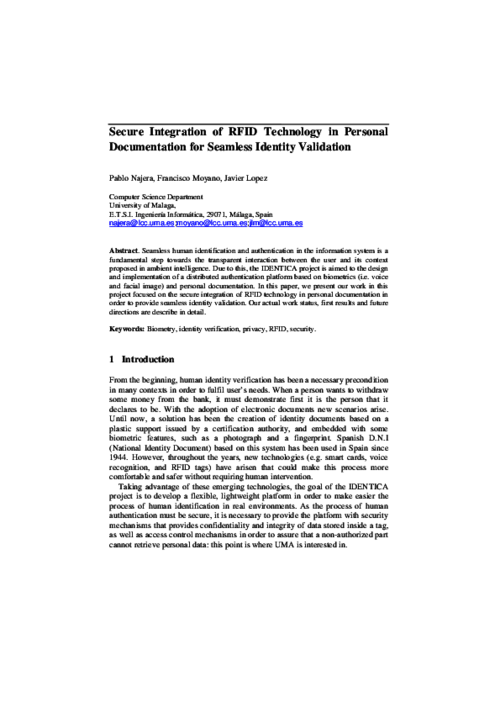
First Workshop in Information and Computer Security (ICS’06), vol. 186, Elsevier, pp. 27-42, 2007. DOI
Abstract
Temporal logics of knowledge are useful for reasoning about situations where the knowledge of an agent or component is important, and where change in this knowledge may occur over time. Here we investigate the application of temporal logics of knowledge to the specification and verification of security protocols. We show how typical assumptions relating to authentication protocols can be specified. We consider verification methods for these logics, in particular, focusing on proofs using clausal resolution. Finally we present experiences from using a resolution based theorem prover applied to security protocols specified in temporal logics of knowledge.
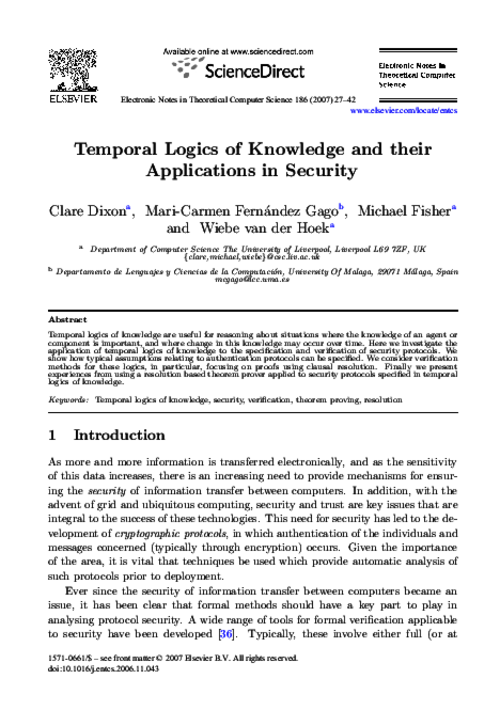
First International Conference on Ambient Intelligence Developments (AmID’06), Springer, pp. 108-123, September, 2006. DOI
Abstract
The realization of the Ambient Intelligence concept entails many important challenges, but the most important barriers to this realization is the lack of adequate support for security. In this paper we present a conceptual model of our solution for building secure systems for AmI environments, taking as basis the concept of Security and Dependability (S&D) Pattern as a precise representation of validated S&D solutions and mechanisms. The main elements embedded in our solution framework (S&D library, monitoring interface and S&D Manager) are presented both conceptually, and also using a simple example scenario based on an hospital AmI environment.
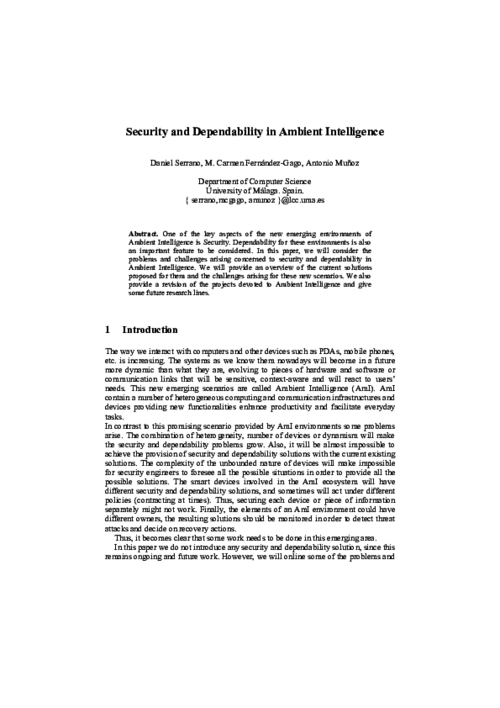
 ]
] 